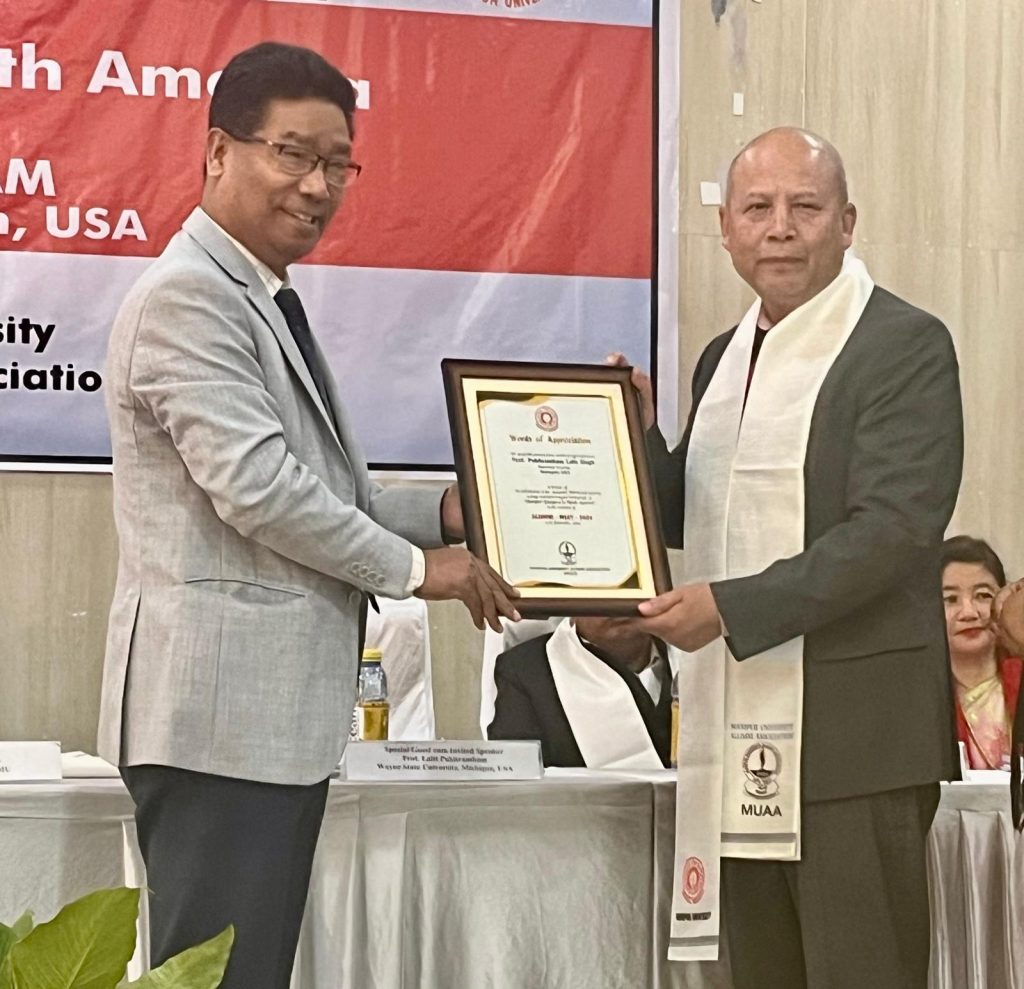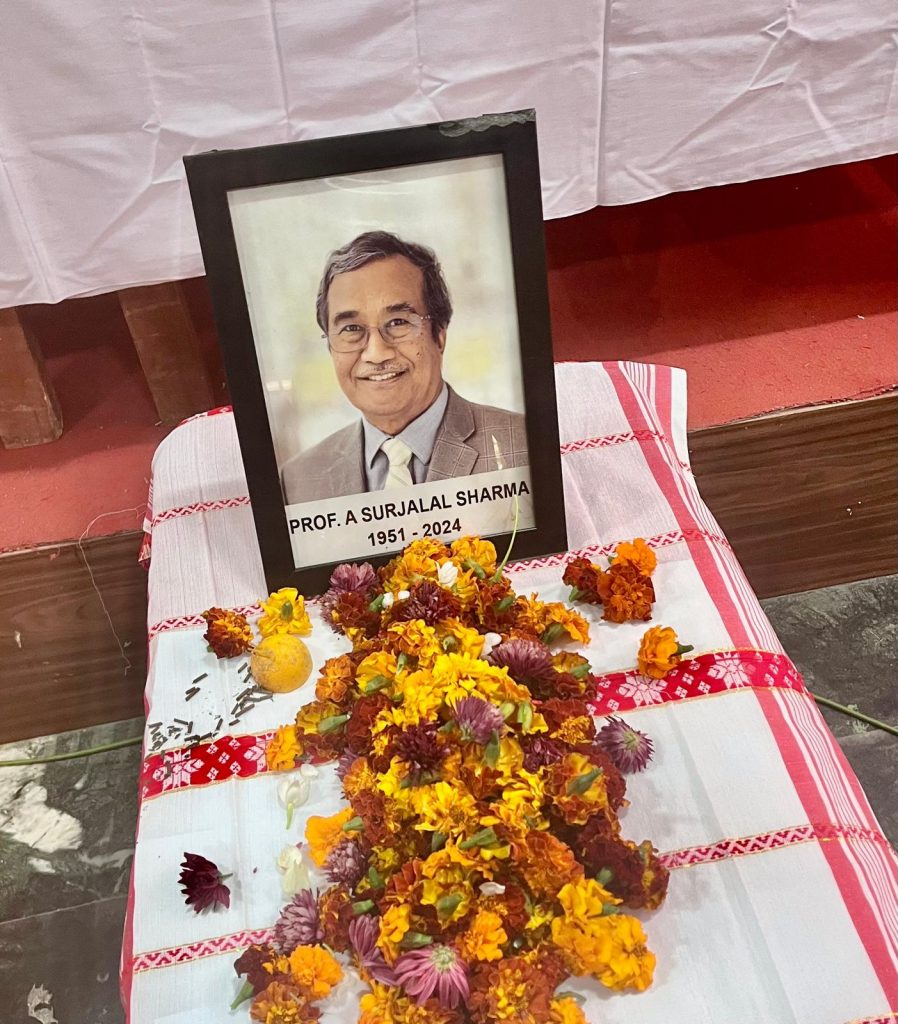NAMA Grant Award Ceremony at Manipur University, Imphal – December 27, 2024
Dr. Lalit Pukhrambam
Chair, Board of Trustees, NAMA
January 24, 2025 (Wakching 25 Panba)


Today is one month after my father’s Shraddha ceremony at Kakching on December 24, 2024. I and my family (wife and children) made a short trip to Manipur to attend the Shraddha ceremony. As the word of father’s demise and our travel plan to Manipur was shared with some of our friends in the United States, I learnt that the timing of my visit coincided with the award ceremony of the Dr. A. Surjalal Sharma Memorial Grant on December 27, which was organized by NAMA (North American Manipur Association) and RIST (Research Institute of Science and Technology, Imphal). I was in a very tight schedule with our family and relatives and our return back to the United States from Imphal was scheduled for December 28. On December 26, we also had a ceremony at the Divine Life Society, Kakching, for my father. My father, (late) Pukhrambam Kunjo Singh, was a renowned writer, social activist and a spiritual leader to many students, individuals, and several organizations. In recognition of his long-standing service to humanity, he was bestowed with the title of Swami Krishna Arpananda Saraswati by the Divine Life Society of India.
On the evening of December 24, just after the Shraddha, I got a call that Dr. A. Surjalal Sharma’s (we call him respectfully Tamo) Phiroi was on December 25 and his wife (Ichema Dilly) and sons (Tonku and Khagi) were also in Imphal to attend the Phiroi. They would like me to be present at the occasion. On hearing this, I went to Imphal in the evening itself and stayed at my wife’s sister’s place at Yaiskul, which is close to Bamon Leikai, the Phiroi place. In the morning, I went for the Phiroi and shared my condolences and expressed happiness to see Ichema and boys and prayed for Tamo’s soul to rest in peace in the heavenly abode. After the Phiroi, I met Professor Nimai (and Professor Rajmuhon, former Vice-Chancellor of Dhanamanjuri University), who are founding members of RIST. Ichema informed me that she and boys would attend the award ceremony. I returned to Kakching again after the ceremony to attend another family function. Because of my hectic schedule, I could not attend to the details of the Award program. Fortunately, with the help of our NAMA executive team in the United States, particularly, President Dr. Thoihen Heisnam, all needed arrangements were done through his parents and Professor Nimai. So, I was just to attend the function on the day itself at 11 AM to 12.30 PM. I was also invited to another program at the Manipur University (MU) with Vice-Chancellor Professor N. Lokendro Singh from 1 PM to 3 PM for the MU Alumni Association (MUAA). And, thereafter, from 3.30 PM to 5 PM, another program at RKCS Gallery at Keishampat. Hence, the day was full of hectic activities till 11 PM in the night with relatives and family members. My body and back were also beginning to crack down from the long flight and nonstop activities at home.
The Dr. A. Surjalal Sharma Memorial Award ceremony started at 11 AM sharp with floral tribute to the picture of Tamo by the dignitaries, family members and attendees. The Vice-Chancellor of MU, the dean of life sciences, the dean of mathematics and physics, and other university professors were present in the function. Ichema, Tonku and Khagi were also present as well as Dr. Thoihen’s father and mother who arranged the Award Certificates. The grant recipients were Mr. Mairembam Kelvin Singh for Physics and Mr. Somi Raikhan for History. In addition, there were four other Honorable Mentions. Details of the grants are available at the NAMA website. Their details are available here [add hyperlink to the grant announcement in the NAMA web].
I was asked to say a few words about Tamo’s life and his role in NAMA and RIST. I gave an account of my meeting with Tamo in Ahmedabad in 1982, and then again in 1990 in the United States, and in various NAMA conventions thereafter. He was the founder member of NAMA and through him we all were bound together during times of both stress and happiness, in good and bad times. He was the President of NAMA during the years 1996-1998. In 2001, one of our founder members and then President of NAMA, Jupiter Yambem lost his life in the Twin Tower attack in New York. The following few years after 9/11 left a void in NAMA. During this time, Tamo Surjalal took the rein for NAMA and became a second time President during 2004-2006. After that he handed over the role of President to me in Michigan in order to spread NAMA to the Mid-West. I took the charge of the President and Mid-West participation started with Chingakham Raj and Priya Koijam (both husband and wife became NAMA Presidents in later years). In this way, Tamo was responsible for spreading NAMA to various parts of the United States, including Texas in the South. We always looked up to him for NAMA, even in difficult time during the ethnic conflict in Manipur. His guidance was always followed by NAMA executive team and members. He also acted as Chair of the Board of Trustees for several years. Here, I also mentioned that NAMA is the oldest organization of Manipuris outside of India, and its name is recognized by the Indian Consulates in the United States as well as by the Government of India during many occasions and functions. Among his qualities, one we have all learnt and appreciated was his calm nature and not showing any anger or displeasure towards anyone or any argument of disagreement.
This quality of his brought NAMA together. Now that he is no more with us, we must learn and continue his legacy. Such a desire was also expressed by RIST, Vice-Chancellor of MU, and Deans to continue the Dr. A. Surjalal Sharma Grant along with other collaborative programs. This is something that NAMA can consider exploring in the future. In terms of RIST, Tamo Surjalal was instrumental in establishing the institute and organizing several research seminars and interaction with students. The desire for RIST to become a full fledged institution of research excellence on its own is quite strong among the members.
Next, the two grant awardees spoke about their projects and their desire to do well in future. Both recipients spoke passionately about their projects and appreciated NAMA for selecting their works for the award. The Vice-Chancellor and the Deans also spoke about their interactions with Tamo Surjalal and family in various ways and capacities. Towards the end, we all had a light refreshment. To cover logistics expenses, I presented on behalf of NAMA a sum of Rs 20,000 to RIST fund. After this program, some local TV and news reporters also took a couple of short interviews with me about NAMA, and the award program. I explained to them to the best of my capability about NAMA and its activities in the United States and in Manipur. The program ended on time at 12 noon as I and the Vice-Chancellor had to attend another program at the University Centenary Hall at 1 PM for the MU Alumni Association’s new member inductees (MUAA) and my invited talk on “Manipuri Diaspora in America”.There, I spoke about NAMA, its members and activities in the United States and Manipur again. In addition, I also mentioned about the education system in the United States, the cost of college education, and why most American students are not able to go for further higher studies after bachelor’s degree due to student loan burden. This lacunae for US universities for post graduate masters and Ph.D. programs are filled up by students from India and China where the education is fully supported by the government. Thus, we find many Indian origin CEOs, Professors, Doctors, and Managers in many companies and institutions in the United States. I also highlighted that many Americans struggle for survival in many big cities like San Francisco, Los Angeles, New York, and other places, because of the high cost of housing, transport, and food items. America is not all glitters as we assume, people there also struggle for their daily lives. Indian families (1.5 percent of the US population) generally do reasonably well in the United States compared to average local Americans. Fortunately, most Meitei families also do reasonably better in the United States along with the Indian diaspora in terms of education and economic stability. Among the diasporas of Manipur, the Meitei community may be about 150 to 200 people altogether whereas the other communities of Manipur are mostly affiliated with their own tribes. There is a lack of communication amongst the different communities of Manipur in the United States, which is also a reflection of the situation in Manipur. Nonetheless, being first-generation migrants and fewer in number, there is a need for cohesiveness and communication within the Manipuri community overcoming the geographical distance amongst cities in the United States. NAMA tries to play a critical role in keeping our diaspora together, regardless of its ethnic background, religion, and caste.
